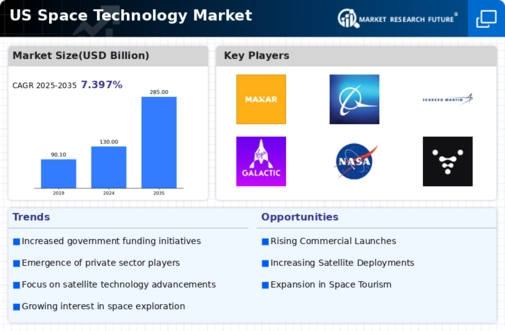Government Funding Initiatives
The space technology market in the US is experiencing a surge in government funding initiatives aimed at enhancing national security and advancing scientific research. The National Aeronautics and Space Administration (NASA) and the Department of Defense (DoD) are allocating substantial budgets, with NASA's budget reaching approximately $25 billion in 2025. This financial support is likely to stimulate innovation and development within the space technology market, fostering collaboration between public and private sectors. Furthermore, the establishment of programs such as the Space Launch System (SLS) and Artemis missions indicates a commitment to long-term investment in space exploration. As a result, the influx of government funding is expected to drive growth and create opportunities for companies involved in the space technology market.
Emergence of New Space Startups
The emergence of new space startups is reshaping the landscape of the space technology market in the US. With a growing number of entrepreneurs entering the sector, innovative solutions and services are being introduced at an unprecedented pace. These startups are often focused on niche markets, such as satellite manufacturing, space debris management, and in-orbit servicing, which are gaining traction. The influx of venture capital investment, which reached approximately $5 billion in 2025, is likely to fuel this trend, allowing startups to develop cutting-edge technologies and compete with established players. Consequently, the diversification of offerings within the space technology market may enhance overall market resilience and adaptability.
Growing Demand for Satellite Services
The demand for satellite services is on the rise, significantly impacting the space technology market in the US. With the increasing reliance on satellite communications, Earth observation, and navigation systems, the market is projected to grow at a compound annual growth rate (CAGR) of approximately 8% from 2025 to 2030. This growth is driven by sectors such as telecommunications, agriculture, and disaster management, which are increasingly utilizing satellite data for operational efficiency. As a result, companies within the space technology market are likely to invest in developing advanced satellite technologies and services to meet this burgeoning demand, thereby enhancing their competitive positioning.
Technological Advancements in Launch Systems
Technological advancements in launch systems are playing a pivotal role in shaping the space technology market in the US. Innovations such as reusable rocket technology and improved propulsion systems are reducing launch costs significantly. For instance, companies like SpaceX have demonstrated the feasibility of reusing rockets, which can lower launch expenses by up to 30%. This reduction in costs is likely to encourage more frequent launches and expand access to space for various applications, including satellite deployment and scientific research. As the market evolves, these advancements may lead to increased competition and a broader range of services offered within the space technology market, ultimately benefiting end-users and stakeholders alike.
International Collaboration in Space Exploration
International collaboration in space exploration is becoming increasingly prominent, influencing the dynamics of the space technology market in the US. Partnerships between NASA and international space agencies, such as the European Space Agency (ESA) and the Indian Space Research Organisation (ISRO), are fostering knowledge exchange and resource sharing. These collaborations are likely to enhance the capabilities of the US space technology market, enabling access to diverse technologies and expertise. Moreover, joint missions, such as the Lunar Gateway project, exemplify the potential for shared objectives in space exploration. This collaborative approach may lead to accelerated advancements and a more integrated global space community.






















Leave a Comment